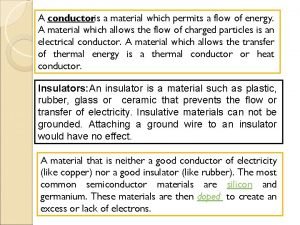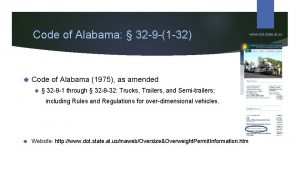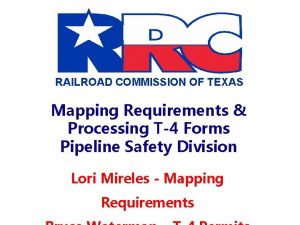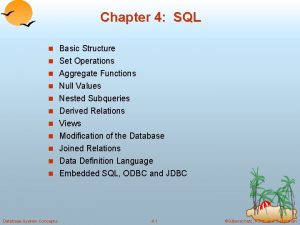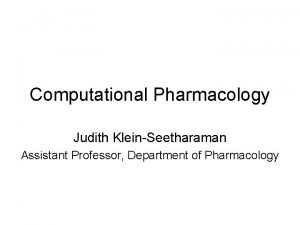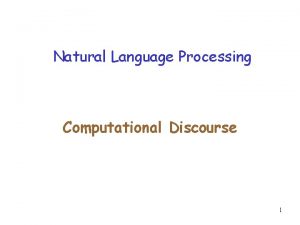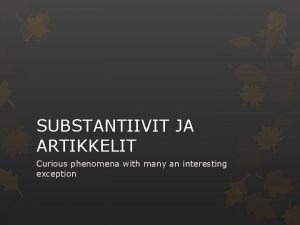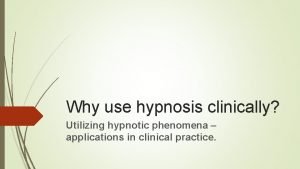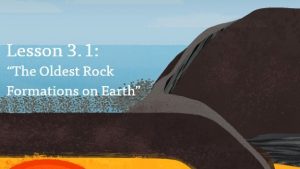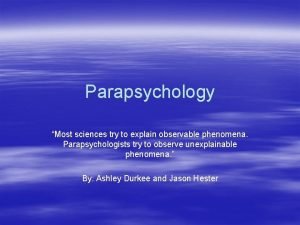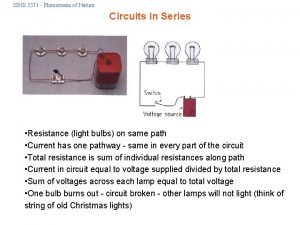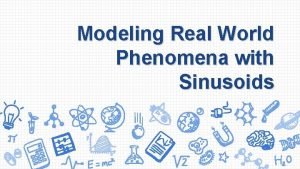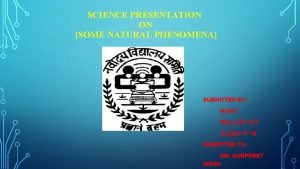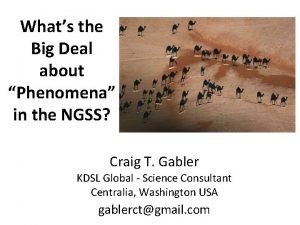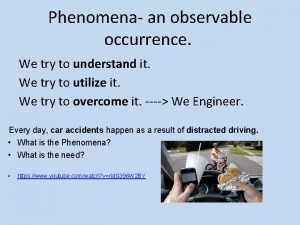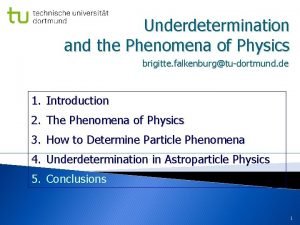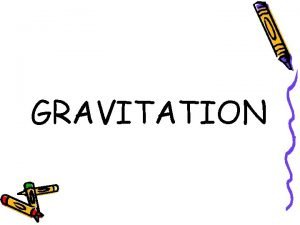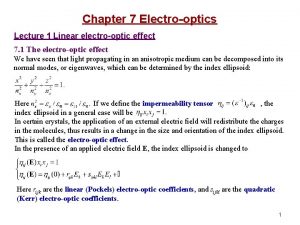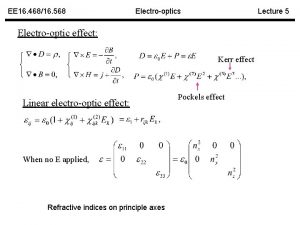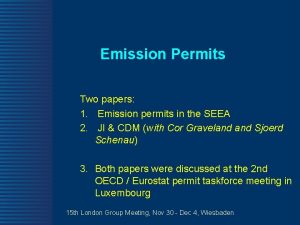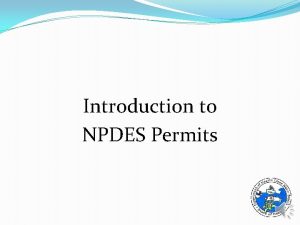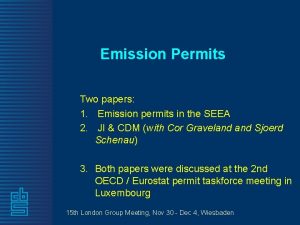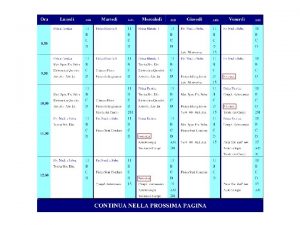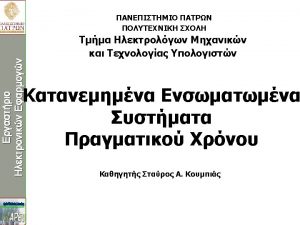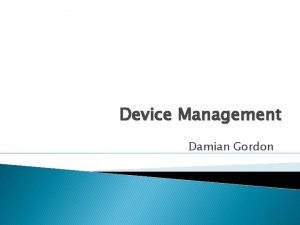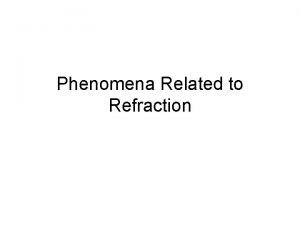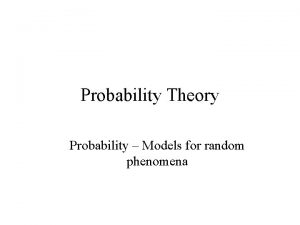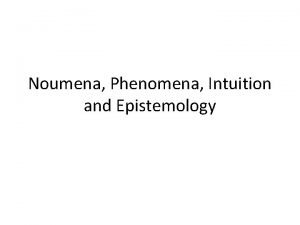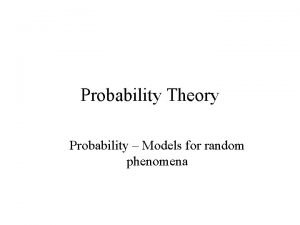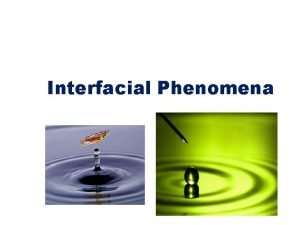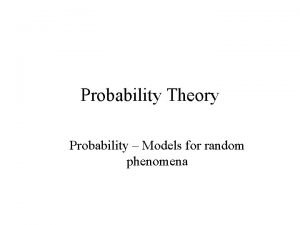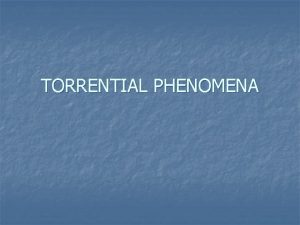ElectroOptics The Phenomena An electrooptic material device permits































- Slides: 31

Electro-Optics: The Phenomena • An electro-optic material (device) permits electrical and optical signals to “talk” to each other through an “easily perturbed” electron distribution of a material. A low frequency (DC to 200 GHz) electric field (e. g. , a television [analog] or computer [digital] signal) is used to perturb the electron distribution (e. g. , electrons of an organic chromophore) and that perturbation alters the speed of light passing through the material as the electric field component of light (photons) interacts with the perturbed charge distribution. • Because the speed of light is altered by the application of a “control” voltage, electro-optic materials can be described as materials with a voltage-controlled index of refraction. Index of refraction = speed of light in vacuum/speed of light in material

Electro-Optic Devices: The on-ramps & interchanges of the information superhighway • By slowing light down in one arm of the Mach Zehnder device shown below, the interference of light beams at the output can be controlled. Electrical information appears as an amplitude modulation on the optical transmission. This works equally well for analog or digital data. Electro-optic coefficient is the material parameter that defines how large an effect is observed for a given applied voltage l = optical wavelength n = index of refraction r 33 = electro-optic coefficient L = interaction length G= modal overlap integral d = electrode gap The Mach Zehnder Interferometer Vp = ld/(2 n 3 r 33 LG) DC bias electrode ground electrode Modulated Light Out Light In RF electrode Substrate Vp is the voltage required to achieve signal transduction


Electro-Optic Behavior Depends on Orbital Type and Position Pi-electrons are more easily perturbed (displaced) than sigma-electrons

Example of common NLO chromophore design Electron Acceptor Electron Donor -conjugated bridge v PAS 38, a classical linear charge-transfer chromophore shows typical chromophore design; an electron donor and acceptor pair separated by a -conjugated bridge

Example of an E-O Chromophore: A Charge Transfer (Dipolar) Molecule Charge displacement can occur over estended distances using materials with extended p-conjugation The charged separated form will have a larger dipole moment and thus a stronger interaction with an applied electric field

NONLINEAR OPTICAL EFFECTS: Microscopic and Macroscopic Polarization—Power Series Expansion v is the first nonlinear term, known as molecular first hyperpolarizability v For a symmetric molecule even order terms, and higher, are zero. v (2)represents material first nonlinear susceptibility v Oscillators (chromophores) must be aligned acentrically within the material to realize a nonzero (2)

The coefficient of the second term in the power series expansion of material Polarization in terms of applied electric fields, c(2), is given by r 33 = b. N<cos 3 q>(constant) Loading Parameter = N<cos 3 q> = (r 33/b)(constant) r 33 = electro-optic coefficient N = chromophore number density (molecules/cc) = molecular first hyperpolarizability N<cos 3 q> = acentric order parameter *The constant depends on the dielectric properties of the material lattice

Optimization of Electro-Optic Activity Macroscopic Level Electro-optic activity requires noncentrosymmetric chromophore symmetry, i. e. , <cos 3 q> must be large Requires optimization of N<cos 3 q> *Statistical mechanics is the key Molecular Level Requires optimization of b *Quantum mechanics is the key Let us first focus on the optimization of N<cos 3 q>, then we will consider the optimization of b.

Use Electric Field Poling to Induce Noncentrosymmetric Order A DC poling field is applied across the chromophore / host matrix. E F i e l d Top electrode Bottom electrode Ideal case (no intermolecular interactions) : < cos 3 θ> = E / 5 k. T

NONCENTROSYMMETRIC SYMMETRY REQUIRED FOR ELECTROOPTIC ACTIVITY Translating Microscopic to Macroscopic Electro-Optic Activity r 33 = b. N<cos 3 q>(constant) L = Langevin Function; W = Intermolecular Electrostatic Potential; k = Boltzmann constant; Ep is applied poling field; F is poling field felt by chromophore

EO Activity vs. Concentration: Theory & Experiment CLD in APC Statistical mechanical calculations permit understanding the role that chromophore shape has on macroscopic electrooptic activity

Chromophore Shape Determines EO Activity Loading Parameter = N<cos 3 q> r 33/b(constant) Region of Enhanced Order

1 2 With a 2 -1 aspect-ratio dipolar head-tail interactions are becoming predominant over side-side interactions Undesired Centrosymmetric Order Desired Noncentrosymmetric (EO active) Oder

Towards improved loading: discotic chromophores

Progress In Discotic Chromophores Relative r 33 values for a series of modified bi(Pro. DOT) core in bridges. The more disc shaped, the more the dipole-dipole interaction are reduced. Prediction: OLD-4 can go to higher loading and still get improved electro-optic conversion. The wt% loading is based on core chromophore weight only. Wt % 20% 30 % OLD-1 3. 0 --OLD-2 2. 0 3. 6 OLD-3 1. 0 --- OLD-4 4. 0 ---

Blends of Organic Molecular Glass Materials AJC-AJC (50%) 400 HD/FD-AJC(75%) AJC-AJC(75%) 350 HD/FD-AJC(50%) r 33 (pm/V) 300 HD/FD-AJC(23%) HD/FD 250 200 150 100 50 0 0 20 40 60 Poling field (V/um) 80 100 AJC 146 AJC 168

Multi-Chromophore-Containing Dendrimers Require the Use of Psuedo-Atomistic Monte Carlo Calculations to Simulate Poling-Induced Noncentrosymmetric Order Simulation requires consideration of Intermolecular electronic (e. g. , dipole-dipole) interactions Intermolecular nuclear repulsive (steric) interactions Potential functions associate with rotation about covalent bonds Van der Waals interactions It is critical to reduce computation time by making logical approximations Treat pi-electron segments within the United Atom Approximation (Pi bonds prevent rotation and segments are thus rigid) Treat sigma-electron segments atomistically using correct bond rotation potentials

Examples of Monte Carlo Simulations Consideration of Various Modes of Attachment of Chromphore

D 2. pas. 41 VIII MC modeling in static DC field (Simulation of Results for Side-On Attachment Dendrimer) • Chromophores are the prolate ellipsoids. Solvent is assumed. Low Density 2% loading Simmulations performed by Harry Rommel and Bruce Robinson.

PAS Side-On Dendrite: High Density <cos 3 q> greater than 0. 3

Discussion of Results are complicated as might be expected when multiple forces influence results Van der Waals interactions are clearly important in defining the order achieved in the preceding two figures Thus, results are not as simple as for the case of single chromophore dendrimers where the competition of electronic and nuclear intermolecular interactions dominate Covalent bond potentials do prevent dipole-dipole interactions from diving centrosymmetric ordering The two preceding slides clearly demonstrate that covalent bond potentials and nuclear repulsive (steric) interactions can result in order parameter increasing with concentration The next slide shows another possibility: The sum of interactions favors the noncentrosymmetric ordering potential component of the electronic intermolecular interactions

Optimum Monte Carlo Calculated Structure --Noncentrosymmetric Order By Design- • • Three chromophores (End-on attachment) -- 20 Debye dipole each Best of Set of accepted M. C. moves. Result: Near perfect order of 3 Chromophores This is a limiting case: Very Large Field ( 3000 MV/m) Points on Z (up) Magic Angle Chromophore Center

Another Experimental Demonstration: Comparison of chromophore/APC composite with pure three arm chromophore dendrimer (D 2 PASS) The demonstration of the advantage of incorporating a chromophore into a multi-chromophore dendrimer is shown in the figure to the right. An electro-optic activity approximately three times greater than the best value that can be obtained for a chromophore/polymer composite is achieved.

Summary of Multi-Chromophore Dendrimer Results Electro-optic coefficients (at 1. 3 microns wavelength) in the range 200 -430 pm/V have been achieved with multichromophore containing dendrimers Ultimate electro-optic values (supermolecular structures) have not yet been achieved so values can be expected to become larger in the future Electro-optic activity can also been increased by inserting chromophores with greater molecular first hyperpolarizability into optimized supermolecular structures. We now turn our attention to optimizing chromophore hyperpolarizability

Comparison of Experimental Results and Theoretical Predictions Hyperpolarizability values relative to p. NA measured by HRS and calculated by DFT. Electro-optic coefficients determined by simple reflection Cmpd r 33(pm/V) # 1. 3 m@20% Experiment. relative to p. NA DFT Calculations 1 ---- 3. 5 4. 6 2. 4 2 5 5. 7 4. 8 3. 6 4 /3 25 / ---- 42. 2 /33. 3 43. 5 / 35. 5 44 / 11. 4

Theoretical Prediction of Variation of Molecular First Hyperpolarizability and Dipole Moment with Chromophore Structure (Semi-Empirical Calculation Predictions)

Determination of Molecular 1 st Hyperpolarizability (relative to CHCl 3) by Femtosecond, Wavelength-Agile Hyper-Rayleigh Scattering (HRS) --Experiment confirms theoretical prediction-- bchloroform = 0. 16 x 10 -30 esu [Kaatz et al, Opt. Commun. 157 (1998) 177] bchloroform = 0. 49 x 10 -30 esu [Clays et al, Phys. Rev. Lett. 66 (1991) 2980]

Density Functional Theory (DFT) Calculations Predict The Same General Trends

Strategy for Improving NLO Chromophores: Choose the Right Combination of Donor, Bridge, and Acceptor With Theoretical Guidance

Summary Values of electro-optic activity greater than 300 pm/V (an order of magnitude greater than the commercial standard lithium niobate) have been realized for both single and multi-chromophore -containing dendrimers Much greater values can clearly be obtained by Using pseudo-atomistic Monte Carlo calculations to design dendrimers that lead to even larger values of N<cos 3 q> Using quantum mechanical calculations to design chromophores with improved molecular first hyperpolarizability, b. Values of greater than 1000 pm/V are likely possibility. Such materials would likely have a transformative impact on a number of technological areas
 The material that permits the flow of electricity
The material that permits the flow of electricity Internal input devices
Internal input devices Alabama oversize regulations
Alabama oversize regulations Texas air quality permits
Texas air quality permits Riverside county permit portal
Riverside county permit portal City of riverside permit portal
City of riverside permit portal Texas railroad commission pipeline permits
Texas railroad commission pipeline permits St mary's county permits
St mary's county permits What exception if any permits a private pilot
What exception if any permits a private pilot Basic structure of sql
Basic structure of sql Modot carrier express
Modot carrier express If time permits quotes
If time permits quotes Marcellus transportation
Marcellus transportation Denver epermits
Denver epermits Title v air permits 101
Title v air permits 101 Transferable discharge permits
Transferable discharge permits Reference phenomenon in nlp
Reference phenomenon in nlp A moose monikko
A moose monikko Noumena vs phenomena
Noumena vs phenomena Reoulox phenomena
Reoulox phenomena Anchor phenomena
Anchor phenomena Observable phenomena psychology
Observable phenomena psychology Noumena vs phenomena
Noumena vs phenomena Sinusoidal functions as mathematical models
Sinusoidal functions as mathematical models Which are not purely surface phenomena
Which are not purely surface phenomena Natural phenomena introduction
Natural phenomena introduction Noumena vs phenomena
Noumena vs phenomena Observable phenomena meaning
Observable phenomena meaning Global climate phenomena
Global climate phenomena Objective phenomena
Objective phenomena Brigitte falkenburg
Brigitte falkenburg Gravitation is a natural phenomenon where
Gravitation is a natural phenomenon where
